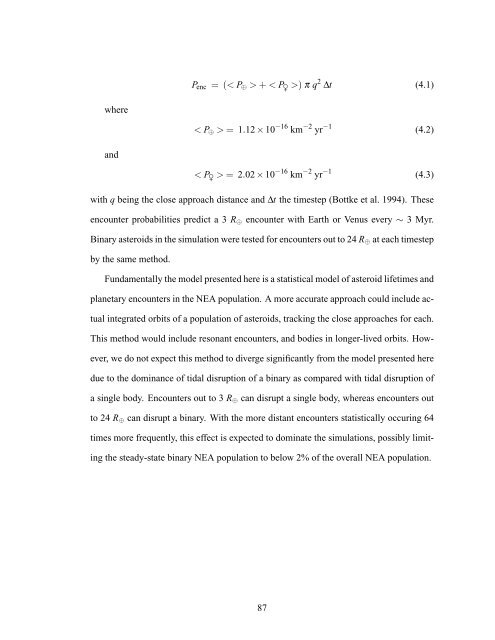Forming Binary Near-Earth Asteroids From Tidal Disruptions
Forming Binary Near-Earth Asteroids From Tidal Disruptions
Forming Binary Near-Earth Asteroids From Tidal Disruptions
Create successful ePaper yourself
Turn your PDF publications into a flip-book with our unique Google optimized e-Paper software.
P enc = (< P ⊕ > + < P♀ >) π q 2 ∆t (4.1)where< P ⊕ > = 1.12 × 10 −16 km −2 yr −1 (4.2)and< P♀ > = 2.02 × 10 −16 km −2 yr −1 (4.3)with q being the close approach distance and ∆t the timestep (Bottke et al. 1994). Theseencounter probabilities predict a 3 R ⊕ encounter with <strong>Earth</strong> or Venus every ∼ 3 Myr.<strong>Binary</strong> asteroids in the simulation were tested for encounters out to 24 R ⊕ at each timestepby the same method.Fundamentally the model presented here is a statistical model of asteroid lifetimes andplanetary encounters in the NEA population. A more accurate approach could include actualintegrated orbits of a population of asteroids, tracking the close approaches for each.This method would include resonant encounters, and bodies in longer-lived orbits. However,we do not expect this method to diverge significantly from the model presented heredue to the dominance of tidal disruption of a binary as compared with tidal disruption ofa single body. Encounters out to 3 R ⊕ can disrupt a single body, whereas encounters outto 24 R ⊕ can disrupt a binary. With the more distant encounters statistically occuring 64times more frequently, this effect is expected to dominate the simulations, possibly limitingthe steady-state binary NEA population to below 2% of the overall NEA population.87












